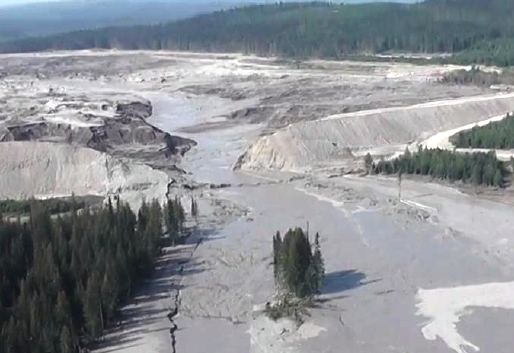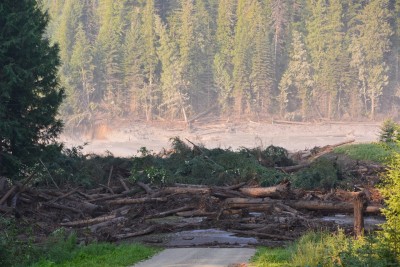
This aerial image shows Monday’s Mount Polley Mine tailings dam break and some of the damage downstream. Fishing and environmental groups say the same could happen at new B.C. mines near the Southeast border. (Cariboo Regional District Emergency Operations Centre photo)
A tailings-dam break at a British Columbia copper and gold mine could threaten Southeast Alaska salmon fisheries.
That’s according to critics, who say similar dams closer to the border could suffer the same fate, polluting Alaska waters.
Monday morning’s dam break took place at the Mount Polley Mine, about 400 miles southeast of Ketchikan.
Scroll down or click here for a video showing the damage.
Observers estimate enough water, mud and rock to fill 2,000 Olympic-sized swimming pools escaped. Emergency officials warned downstream residents against drinking from affected waterways.
That includes salmon-rich tributaries of the Fraser River, which empties into the Pacific Ocean at Vancouver, B.C.
Brian Lynch of the Petersburg Vessel Owners Association says some of those fish swim north.
“The United States has a harvest-sharing arrangement for Fraser sockeye and pink salmon through provisions of the Pacific Salmon Treaty. So any problem associated with salmon production on the Fraser will affect U.S. fishermen,” he says.

Muddy water from the breached Mount Polley Mine tailings pond dam floods a downstream creek and road Monday. (Cariboo Regional District Emergency Operations Centre photo)
Imperial Metals, the Mount Polley Mine’s owners, did not respond to a request for comment. That’s been the case with requests on other issues too. The corporate website says the mine is not operating and they don’t know how long repairs will take.
A half-dozen or so similar mines are planned for northwest British Columbia, closer to the Alaska border.
Guy Archibald of the Southeast Alaska Conservation Council says they all plan to store tailings, which contain acidic rock and toxic metals, behind dams similar to the one that broke.
“They’re all basically the same systems. They have to comply with the same regulations and design criteria,” he says.
Archibald and Lynch are especially concerned about the Kerr-Sulphurets-Mitchell project, under development about 20 miles from the Alaska border.
KSM will store tailings behind dams upstream from the Nass River, which ends just south of Alaska’s border with British Columbia.
Environmental Affairs Vice President Brent Murphy says it’s not the same as the Mount Polley dam.
“The design of the tailings management facility is such that water will not be standing up against the crest of the dam. Any ponds will be at least kilometers away from the crest of the dams,” he says.
The Mount Polley break may have been caused by heavy rainfall and increased production added pressure to the dam.
The KSM also plans a water treatment storage dam upstream from the Unuk River, which enters the ocean northeast of Ketchikan. It would be part of a system treating acidic water from mine pits and tunnels.
Murphy says it’s designed to spill extra water rather than hold it beyond capacity.
“That contact water would have characteristics very similar to the water that is currently flowing naturally within the Suphurets-Unuk river system,” he says.
KSM’s dam plans have been OK’d by Canadian provincial and federal officials. Murphy says they also passed muster with independent engineers.
Lynch of the Petersburg Vessel Owners Association says the Mount Polley dam had the same approval.
“This was not only obviously a tailings dam failure but it appears to be a regulatory oversight failure as well. And that’s what we want to prevent on any mines going into the transboundary systems,” he says.
Public comments on provincial environmental approval are being taken through Aug. 20.
The Mount Polley mine owner, Vancouver-based Imperial Metals, plans to open the Red Chris Mine, in the Stikine River watershed this fall. Like Mount Polley and KSM, it’s an open-pit copper and gold mine.








